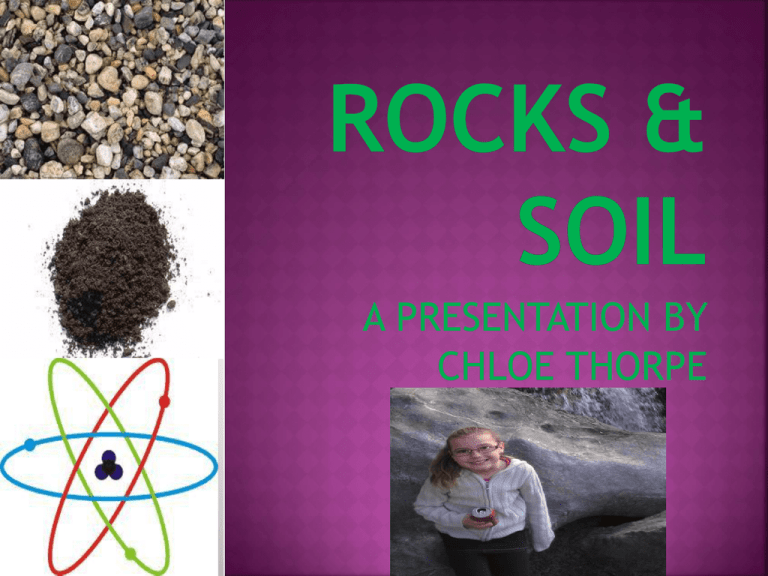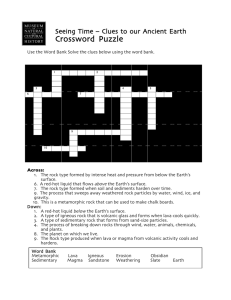rocks & soil - St Helens Park Public School
advertisement

A PRESENTATION BY CHLOE THORPE CHARACTERISTICS OF ROCKS COLOR TEXTURE HARDNESS WEIGHT The Three types of rocks Igneous rocks are called fire rocks and are formed either underground or above ground. Underground, they are formed when the melted rock, called magma, deep within the earth becomes trapped in small pockets. As these pockets of magma cool slowly underground, the magma becomes igneous rocks. Igneous rocks are also formed when volcanoes erupt, causing the magma to rise above the earth's surface. When magma appears above the earth, it is called lava. Igneous rocks are formed as the lava cools above ground. Rhyolite is a light- colored volcanic rock. It has a high silica content which makes it very viscous. This prevents gases from escaping causing rhyolite eruptions to be explosive. Rhyolite has a silica (SiO2) content greater than about 68 percent by weight. Obsidian is usually black in color though it can also be red or have a greenish tint. It is a dense volcanic glass, usually composed of rhyolite, rich in iron and magnesium.Obsidian is formed when the lava cools so quickly that crystals do not have time to grow. Obsidian fractures with very sharp edges. It was used by Stone Age cultures for making knives, arrowheads, and other tools where sharp edges are important. Pumice is light and porous. It forms during explosive eruptions. Pumice is full of holes caused by expanding volcanic gases. It is composed of volcanic glass and minerals, and can form in all types of magma: basalt, andesite, dacite, and rhyolite. Sedimentary rock is formed by mineral and other materials sitting in water for an extremely long time. While the minerals and other materials are in the water, they will have various things put pressure on them. After being exposed to these conditions for so long, it forms into sedimentary rock. SANDSTONE is sand grains cemented together into solid stone. SHALE is made from silt particles cemented together. It is similar to siltstone but with even finer grain size, LIMESTONE is made primarily of calcium carbonate or calcite. The most common source of this calcite is the shells of marine organisms Igneous rocks form from the solidification of lava or magma. If it forms intrusively, or within the earth, the rock will have large crystals. Granite is an example of such a coarse-grained igneous rock. If the rock forms extrusively, or on the earth's surface, it will have fine-grained crystals. Obsidian is an example of a fine-grained igneous rock. SLATE is a fined grained metamorphic rock. MARBLE is a metamorphic rock that comes from metamorphosed limestone or dolomite. QUARTZITE is a coarse-grained metamorphic rock derived from sandstone. The upper layer of earth in which plants grow, a black or dark brown material typically consisting of a mixture of organic remains SILTY SANDY PEATY CLAY SALINE ? YES!! AN EASY DEFINITION IS Rock is one object. and Soil is a mixture of rocks (rather small rocks: dirt), water, minerals, bacteria, plant, animal, fungi matter etc. Erosion causes include - gravity, rain, flooding, wind, drought, deforestation, farming, flowing ice Which effects the rock and soil by desertification, additional sedimentation, loss of habitat, infertile soils, increased use of soil conditioners and fertilizers, water pollution http://agverra.com/blog/soil-types/ http://answers.yahoo.com/question/ http://en.wikipedia.org/wiki/erosion http://en.wikipedia.org/wiki/List_of_rock_t ypes http://www.zephyrus.co.uk/rocktypes.html http://adventuresinscience.edublogs.org/cat egory/kids-corner/ http://growingchillies.net/growing-chilliessoil-tips/ http://www.soilsurvey.com.au/services.html







